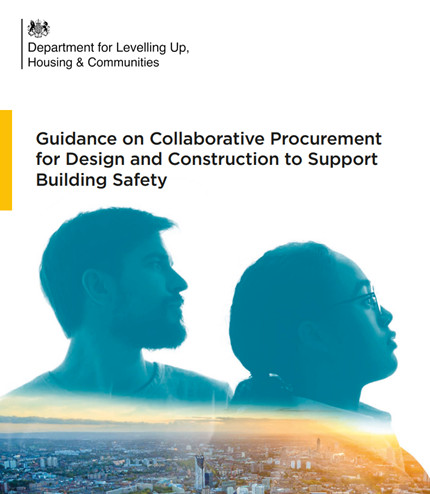On Monday 4th November, the Procurement Group met to discuss the Building Safety Act, with a specific focus on Dame Judith Hackitt’s recommendations around Data, Contract Management and Procurement.
The group were fortunate to be joined by Amanda Stubbs, partner at Trowers and Hamlins, and Dr Bola Abisogun OBE, Founder & Chief Excitement Officer at Digital Twin Skills Academy, to explore the Golden Thread and the importance of information creation and preservation through the project and lifecycle of a building. The group also learned more about MHCLG’s Procurement Advisory Group’s Guidance on ‘Collaborative Procurement for Design and Construction to Support Building Safety’.
Collaborative Procurement for Design and Construction to Support Building Safety
The Building Safety Act recommendations refer to contracting and procurement in a number of ways and recognise that Collaborative Procurement is the way forward. Whilst these areas were not developed in legislation, guidance was produced to provide a better understanding of procurement, contract management and date and to give examples of best practice.
MHCLG set up a Procurement Advisory Group to assist with the review of technical guidance for procurement and ultimately produced ‘Guidance on Collaborative Procurement for Design and Construction to Support Building Safety’.
The guidance recommends procurement and contracting questions that should be addressed in advance of each of 3 ‘gateways’…
- Planning Gateway 1- the planning and application stage
- Gateway 2- before building starts
- Gateway 3- when building is complete
It also sets out guidance around:
- selection by value that avoids a race to the bottom
- early supply-chain involvement that improves safety and reduces risks
- collaboration relationships that improve commitments and involved residents
- a golden thread of information that integrates design, construction and operation
- what systems sustain and enhance a collaborative culture
- how strategic collaboration can embed improved safety
- how collaborative procurement enables public and private sector clients and their teams to achieve other improvements in economic, social and environmental value
![]()
Contracting Issues
Solving issues around contracting is key to successful information passing. All contracts need amending because standard forms don’t enable consistent information throughout design, construction, and handover stage. Some of the problems we face with contracts include:
- Most contracts & forms of appointment need amending to include compliance with Dutyholder and competency requirements.
- Concerns over how the building safety regulator reviews gateway applications at the moment that make timings more risky.
- Most standard forms of contract only cover construction phase of works so will need to complete Gateways 1 & 2 via separate pre-construction agreement or two-stage agreement.
- Contract terms for HRB work will need to consider Gateway 2 & 3 timings
- Consider who takes risk of additions time/cost of delays in approval process and any additional works required
- New HRB projects will need to rethink practical completion/handover/ occupation procedures.
- Gateways process anticipates a collaborative project team sharing information and risk. This may not fit with some current ways of working.

The Higher-Risk Buildings (Keeping and Provision of Information etc.) Regulations 2024 came info force on 16th January 2024 and sets out detailed information and documents Accountable Persons much hold for Higher-Risk Buildings/ Residences within HRBs.
In contracts, it is ensured that prescribed information is allowed for and envisaged. What we need to do now, from a procurement perspective, is ensure that we structure processes in a way that makes the securing and drafting of that information easy and dynamic to enable it to be updated by the collaborative team but remaining with one single version of the truth.
and envisaged. What we need to do now, from a procurement perspective, is ensure that we structure processes in a way that makes the securing and drafting of that information easy and dynamic to enable it to be updated by the collaborative team but remaining with one single version of the truth.
Purpose of the Golden Thread
The Golden Thread has 3 main purposes…
- To demonstrate that the building meets the requirements of the building regulations. This information needs to be in place both on completion of the building and following any refurbishments or changes to the structure.
- To enable those responsible for the building to identify and manage safety risks in order to prevent or reduce them to a level where there’s no risk of serious impact of fire spreading or structural collapse for the build lifetime.
-
To ensue that the dutyholders have demonstrated that they have complied with this piece of legislation.
Digital Record
Dutyholders are required to hold a digital record of the crucial building safety information, starting from the design phase and continuing right the way through.
One of the main problems to date is that information is held all over the place within organisations. It isn’t joined up. Different people who need to know about a building, don’t necessarily have oversight of all of it.
Therefore, one of the main duties of the client building owner is to ensure that the golden thread of information is accurate, up to date and held electronically. It needs to be capable of transferred electronically without being lost or corrupted and has to be in a format that’s intelligible to those that need to understand it. These provisions are in the legislation.
Ultimately the digital record needs to be accessible, easily understood, but secure to ensure only those that have a right to it can access it. Only changes in accordance with procedures should be made and all changes should be traceable according to the work, who did it, when and how.

“We’re all doing it every day at the moment, but we’re all probably doing it in different ways, and one of the things we really need to do well or better is to standardize the way that we share, create, enter and rely upon.”
Dr Bola Abisogun OBE
Upskilling the Industry
Digital records and electronic access to building information pave the way for new technologies and systems across the sector. In order to keep up with this digital transformation, it’s important that construction is upskilling its workers to deal with new requirements and adeptly access new processes.
the way for new technologies and systems across the sector. In order to keep up with this digital transformation, it’s important that construction is upskilling its workers to deal with new requirements and adeptly access new processes.
The Golden Thread lends itself well to innovative technologies such as Digital Twins. The question is, are we, as an industry, ready to engage with these new solutions to the requirements of the Building Safety Act?
We need to ensure we are engaging young people, the next generation of construction, to take on the digital challenge construction faces as they are quicker and more able to move with advancements in technology and will be bringing this to construction in the future.
Get Involved
If you would like to join our upcoming Procurement Group sessions, which will delve further into other aspects of the Building Safety Act, take a look at our Procurement page. Or find out more about our other groups here, all are welcome.




